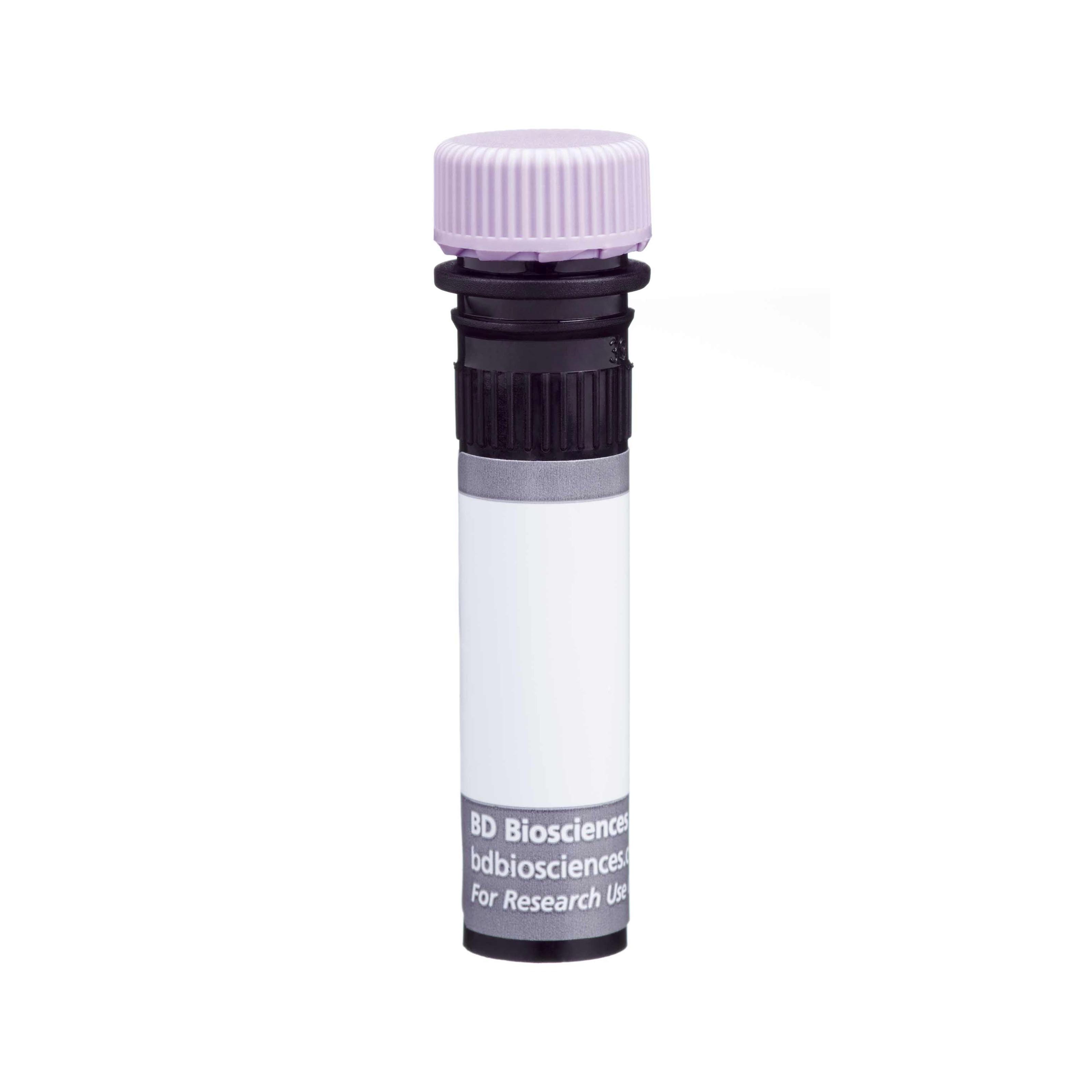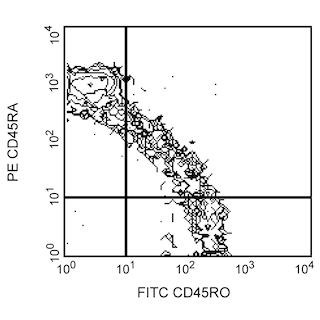-
Training
- Flow Cytometry Basic Training
-
Product-Based Training
- BD Accuri™ C6 Plus Cell Analyzer
- BD FACSAria™ Cell Sorter Cell Sorter
- BD FACSCanto™ Cell Analyzer
- BD FACSDiscover™ A8 Cell Analyzer
- BD FACSDiscover™ S8 Cell Sorter
- BD FACSDuet™ Sample Preparation System
- BD FACSLyric™ Cell Analyzer
- BD FACSMelody™ Cell Sorter
- BD FACSymphony™ Cell Analyzer
- BD LSRFortessa™ Cell Analyzer
- Advanced Training
Old Browser
This page has been recently translated and is available in French now.
Looks like you're visiting us from {countryName}.
Would you like to stay on the current location site or be switched to your location?
BD Horizon™ BUV395 Rat Anti-Human CCR7 (CD197)
Clone 3D12 (RUO)

Two-color flow cytometric analysis of CCR7 (CD197) and CD45RA coexpression patterns on CD4+ or CD8+ Human peripheral blood lymphocytes. Human whole blood was stained with BD Horizon™ BUV395 Rat Anti-Human CCR7 (CD197) antibody (Cat. No. 568681) at 0.5 μg/test along with PE Mouse Anti-Human CD45RA (Cat. No. 555489/556627/561883) antibody and with either FITC Mouse Anti-Human CD4 (Cat. No. 555346/561842) or Alexa Fluor™ 700 Mouse Anti-Human CD8 (Cat. No. 557945/561026) antibodies. Erythrocytes were lysed with BD FACS™ Lysing Solution (Cat. No. 349202). The two-color flow cytometric contour plots showing the correlated expression pattern of CD45RA versus CCR7 CD197) were derived from CD4-positive (CD4+; Left Plot) or CD8-positive (CD8+; Right Plot) gated events with the forward and side light-scatter characteristics of intact lymphocytes. Flow cytometry and data analysis were performed using a BD FACSymphony™ A5 Cell Analyzer System and FlowJo™ Software. Data shown on this Technical Data Sheet are not lot specific.

Two-color flow cytometric analysis of CCR7 (CD197) and CD45RA coexpression patterns on CD4+ or CD8+ Human peripheral blood lymphocytes. Human whole blood was stained with BD Horizon™ BUV395 Rat Anti-Human CCR7 (CD197) antibody (Cat. No. 568681) at 0.5 μg/test along with PE Mouse Anti-Human CD45RA (Cat. No. 555489/556627/561883) antibody and with either FITC Mouse Anti-Human CD4 (Cat. No. 555346/561842) or Alexa Fluor™ 700 Mouse Anti-Human CD8 (Cat. No. 557945/561026) antibodies. Erythrocytes were lysed with BD FACS™ Lysing Solution (Cat. No. 349202). The two-color flow cytometric contour plots showing the correlated expression pattern of CD45RA versus CCR7 CD197) were derived from CD4-positive (CD4+; Left Plot) or CD8-positive (CD8+; Right Plot) gated events with the forward and side light-scatter characteristics of intact lymphocytes. Flow cytometry and data analysis were performed using a BD FACSymphony™ A5 Cell Analyzer System and FlowJo™ Software. Data shown on this Technical Data Sheet are not lot specific.



Two-color flow cytometric analysis of CCR7 (CD197) and CD45RA coexpression patterns on CD4+ or CD8+ Human peripheral blood lymphocytes. Human whole blood was stained with BD Horizon™ BUV395 Rat Anti-Human CCR7 (CD197) antibody (Cat. No. 568681) at 0.5 μg/test along with PE Mouse Anti-Human CD45RA (Cat. No. 555489/556627/561883) antibody and with either FITC Mouse Anti-Human CD4 (Cat. No. 555346/561842) or Alexa Fluor™ 700 Mouse Anti-Human CD8 (Cat. No. 557945/561026) antibodies. Erythrocytes were lysed with BD FACS™ Lysing Solution (Cat. No. 349202). The two-color flow cytometric contour plots showing the correlated expression pattern of CD45RA versus CCR7 CD197) were derived from CD4-positive (CD4+; Left Plot) or CD8-positive (CD8+; Right Plot) gated events with the forward and side light-scatter characteristics of intact lymphocytes. Flow cytometry and data analysis were performed using a BD FACSymphony™ A5 Cell Analyzer System and FlowJo™ Software. Data shown on this Technical Data Sheet are not lot specific.
Two-color flow cytometric analysis of CCR7 (CD197) and CD45RA coexpression patterns on CD4+ or CD8+ Human peripheral blood lymphocytes. Human whole blood was stained with BD Horizon™ BUV395 Rat Anti-Human CCR7 (CD197) antibody (Cat. No. 568681) at 0.5 μg/test along with PE Mouse Anti-Human CD45RA (Cat. No. 555489/556627/561883) antibody and with either FITC Mouse Anti-Human CD4 (Cat. No. 555346/561842) or Alexa Fluor™ 700 Mouse Anti-Human CD8 (Cat. No. 557945/561026) antibodies. Erythrocytes were lysed with BD FACS™ Lysing Solution (Cat. No. 349202). The two-color flow cytometric contour plots showing the correlated expression pattern of CD45RA versus CCR7 CD197) were derived from CD4-positive (CD4+; Left Plot) or CD8-positive (CD8+; Right Plot) gated events with the forward and side light-scatter characteristics of intact lymphocytes. Flow cytometry and data analysis were performed using a BD FACSymphony™ A5 Cell Analyzer System and FlowJo™ Software. Data shown on this Technical Data Sheet are not lot specific.

Two-color flow cytometric analysis of CCR7 (CD197) and CD45RA coexpression patterns on CD4+ or CD8+ Human peripheral blood lymphocytes. Human whole blood was stained with BD Horizon™ BUV395 Rat Anti-Human CCR7 (CD197) antibody (Cat. No. 568681) at 0.5 μg/test along with PE Mouse Anti-Human CD45RA (Cat. No. 555489/556627/561883) antibody and with either FITC Mouse Anti-Human CD4 (Cat. No. 555346/561842) or Alexa Fluor™ 700 Mouse Anti-Human CD8 (Cat. No. 557945/561026) antibodies. Erythrocytes were lysed with BD FACS™ Lysing Solution (Cat. No. 349202). The two-color flow cytometric contour plots showing the correlated expression pattern of CD45RA versus CCR7 CD197) were derived from CD4-positive (CD4+; Left Plot) or CD8-positive (CD8+; Right Plot) gated events with the forward and side light-scatter characteristics of intact lymphocytes. Flow cytometry and data analysis were performed using a BD FACSymphony™ A5 Cell Analyzer System and FlowJo™ Software. Data shown on this Technical Data Sheet are not lot specific.

Two-color flow cytometric analysis of CCR7 (CD197) and CD45RA coexpression patterns on CD4+ or CD8+ Human peripheral blood lymphocytes. Human whole blood was stained with BD Horizon™ BUV395 Rat Anti-Human CCR7 (CD197) antibody (Cat. No. 568681) at 0.5 μg/test along with PE Mouse Anti-Human CD45RA (Cat. No. 555489/556627/561883) antibody and with either FITC Mouse Anti-Human CD4 (Cat. No. 555346/561842) or Alexa Fluor™ 700 Mouse Anti-Human CD8 (Cat. No. 557945/561026) antibodies. Erythrocytes were lysed with BD FACS™ Lysing Solution (Cat. No. 349202). The two-color flow cytometric contour plots showing the correlated expression pattern of CD45RA versus CCR7 CD197) were derived from CD4-positive (CD4+; Left Plot) or CD8-positive (CD8+; Right Plot) gated events with the forward and side light-scatter characteristics of intact lymphocytes. Flow cytometry and data analysis were performed using a BD FACSymphony™ A5 Cell Analyzer System and FlowJo™ Software. Data shown on this Technical Data Sheet are not lot specific.




Regulatory Status Legend
Any use of products other than the permitted use without the express written authorization of Becton, Dickinson and Company is strictly prohibited.
Preparation And Storage
Recommended Assay Procedures
BD® CompBeads can be used as surrogates to assess fluorescence spillover (compensation). When fluorochrome conjugated antibodies are bound to BD® CompBeads, they have spectral properties very similar to cells. However, for some fluorochromes there can be small differences in spectral emissions compared to cells, resulting in spillover values that differ when compared to biological controls. It is strongly recommended that when using a reagent for the first time, users compare the spillover on cells and BD® CompBeads to ensure that BD® CompBeads are appropriate for your specific cellular application.
For optimal and reproducible results, BD Horizon Brilliant™ Stain Buffer should be used anytime BD Horizon Brilliant™ dyes are used in a multicolor flow cytometry panel. Fluorescent dye interactions may cause staining artifacts which may affect data interpretation. The BD Horizon Brilliant Stain Buffer was designed to minimize these interactions. When BD Horizon Brilliant Stain Buffer is used in in the multicolor panel, it should also be used in the corresponding compensation controls for all dyes to achieve the most accurate compensation. For the most accurate compensation, compensation controls created with either cells or beads should be exposed to BD Horizon Brilliant Stain Buffer for the same length of time as the corresponding multicolor panel. More information can be found in the Technical Data Sheet of the BD Horizon Brilliant Stain Buffer (Cat. No. 563794/566349) or the BD Horizon Brilliant Stain Buffer Plus (Cat. No. 566385).
Product Notices
- Please refer to www.bdbiosciences.com/us/s/resources for technical protocols.
- Since applications vary, each investigator should titrate the reagent to obtain optimal results.
- An isotype control should be used at the same concentration as the antibody of interest.
- Caution: Sodium azide yields highly toxic hydrazoic acid under acidic conditions. Dilute azide compounds in running water before discarding to avoid accumulation of potentially explosive deposits in plumbing.
- For fluorochrome spectra and suitable instrument settings, please refer to our Multicolor Flow Cytometry web page at www.bdbiosciences.com/colors.
- Human donor specific background has been observed in relation to the presence of anti-polyethylene glycol (PEG) antibodies, developed as a result of certain vaccines containing PEG, including some COVID-19 vaccines. We recommend use of BD Horizon Brilliant™ Stain Buffer in your experiments to help mitigate potential background. For more information visit https://www.bdbiosciences.com/en-us/support/product-notices.
- Please refer to http://regdocs.bd.com to access safety data sheets (SDS).
- For U.S. patents that may apply, see bd.com/patents.
Companion Products






The monoclonal antibody 3D12 reacts with the human CC chemokine receptor, CCR7. CCR7 (previously known as BLR-2, EBI-1 and CMKBR7), a seven-transmembrane, G-protein-coupled receptor, is the specific receptor for CC chemokines, MIP-3β/Exodus 3/ELC/ CCL19 and 6Ckine/Exodus 2/SLC/TCA4/CCL21. It has been shown that CCR7 mRNA is expressed mainly in lymphoid tissues including spleen, lymph nodes and tonsil. CCR7 mRNA was also detected in peripheral T and B lymphocytes, in bone marrow and cord blood CD34-positive cells and mature dendritic cells. The human CCR7 gene, unlike other CC chemokine receptor genes, has been mapped to chromosome 17q12. The immunogen used to generate 3D12 hybridoma was the N-terminus as well as parts of the second extracellular loop of human CCR7 protein. The monoclonal antibody 3D12 recognizes an epitope mapping to the N-terminus of human CCR7.

Development References (10)
-
Birkenbach M, Josefsen K, Yalamanchili R, Lenoir G, Kieff E. Epstein-Barr virus-induced genes: first lymphocyte-specific G protein-coupled peptide receptors. Nature. 1993; 67(4):2209-2220. (Biology). View Reference
-
Burgstahler R, Kempkes B, Steube K, Lipp M. Expression of the chemokine receptor BLR2/EBI1 is specifically transactivated by Epstein-Barr virus nuclear antigen 2. Biochem Biophys Res Commun. 1995; 215(2):737-743. (Biology). View Reference
-
Kim CH, Pelus LM, White JR, Broxmeyer HE. Macrophage-inflammatory protein-3 beta/EBI1-ligand chemokine/CK beta-11, a CC chemokine, is a chemoattractant with a specificity for macrophage progenitors among myeloid progenitor cells. J Immunol. 1998; 161(5):2580-2585. (Biology). View Reference
-
Lipp M, Burgstahler R, Muller G, et al. Functional organization of secondary lymphoid organs by the chemokine system. Curr Top Microbiol Immunol. 2000; 251:173-179. (Immunogen: Functional assay, Inhibition). View Reference
-
Sallusto F, Lenig D, Forster R, Lipp M, Lanzavecchia A. Two subsets of memory T lymphocytes with distinct homing potentials and effector functions. Nature. 1999; 401(6754):708-712. (Clone-specific: Flow cytometry, Fluorescence activated cell sorting). View Reference
-
Schweickart VL, Raport CJ, Godiska R, et al. Cloning of human and mouse EBI1, a lymphoid-specific G-protein-coupled receptor encoded on human chromosome 17q12-q21.2. Genomics. 1994; 23(3):643-650. (Biology). View Reference
-
Yanagihara S, Komura E, Nagafune J, Watarai H, Yamaguchi Y. EBI1/CCR7 is a new member of dendritic cell chemokine receptor that is up-regulated upon maturation. J Immunol. 1998; 161(6):3096-3102. (Biology). View Reference
-
Yoshida R, Imai T, Hieshima K, et al. Molecular cloning of a novel human CC chemokine EBI1-ligand chemokine that is a specific functional ligand for EBI1, CCR7. J Biol Chem. 1997; 272(21):13803-13809. (Biology). View Reference
-
Yoshida R, Nagira M, Imai T, et al. EBI1-ligand chemokine (ELC) attracts a broad spectrum of lymphocytes: activated T cells strongly up-regulate CCR7 and efficiently migrate toward ELC. Int Immunol. 1998; 10(7):901-910. (Biology). View Reference
-
Yoshida R, Nagira M, Kitaura M, Imagawa N, Imai T, Yoshie O. Secondary lymphoid-tissue chemokine is a functional ligand for the CC chemokine receptor CCR7. J Biol Chem. 1998; 273(12):7118-7122. (Biology). View Reference
Please refer to Support Documents for Quality Certificates
Global - Refer to manufacturer's instructions for use and related User Manuals and Technical data sheets before using this products as described
Comparisons, where applicable, are made against older BD Technology, manual methods or are general performance claims. Comparisons are not made against non-BD technologies, unless otherwise noted.
For Research Use Only. Not for use in diagnostic or therapeutic procedures.